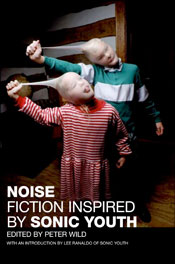
Noise: Fiction Inspired by Sonic Youth
Edited by Peter Wild
Harper Collins

Trading on the reputation of your artistic peers is a risky move, but everything in the publishing world is a risk in the Internet age. Thousands of pages of good fiction have been playing needle in the haystack as far back as the printing press can remember, but these days – when books have literally been reduced to Kindle-ing – it’s that much harder for a short story collection to stand out. So, Peter Wild’s idea to assemble a short story anthology inspired by the music of Sonic Youth is a smart way to attract readers. The risk is that Sonic Youth’s fan base will have high expectations of any book bearing the band’s name, whether it comes with a Lee Ranaldo introduction or not.
From the early sturm und drang of their dismantled rock trash to their melodic second act – defined by the double album masterpiece Daydream Nation – Sonic Youth can be both dissonant and gorgeous. Their songs are populated by characters who are ambivalent, fiery, disenfranchised. Their New York aesthetic is cool and disinterested, they live for the mystery and noise of the human heart as well as the squall of the urban sprawl. It is this spirit fans expect to encounter in Noise.
With the myriad of approaches Peter Wild could have taken to curating this anthology, it’s dumbfounding… the roads he left untraveled. Wild could have assembled writers in the spirit of Sonic Youth – “noisy” experimentalists defying traditional narrative and structure; Ben Marcus comes to mind. Yet, there aren’t any pieces that deconstruct the short story the way Sonic Youth deconstructs rock and roll. Only Shelley Jackson’s absurdist, “Jabberwocky”-esque jibberish “My Friend Goo” is truly subversive. Noise could explore the real life characters who populate Sonic Youth’s songs: The Charles Manson Family of “Expressway to Yr Skull/Death Valley ‘69,” Anita Hill (“Youth Against Fascism [Hate Song]),” Madonna (subject of the entire Ciccone Youth project), or New York City itself. Tom McCarthy’s springy prose presents the kind of fractured America that Sonic Youth’s protagonists populate, with his micro-biography of Patty Hearst during her time with the Symbionese Liberation Army in “Kool Thing; Or Why I Want to Fuck Patty Hearst.” The other authors toil in the playground of mostly anonymous misanthropes who inhabit many of Sonic Youth’s songs, but this approach is indistinguishable from most contemporary literature. Legendary science fiction writer William Gibson inspired songs like “Pattern Recognition” and Philip K. Dick, author of A Scanner Darkly, inspired the album Sister, yet there’s no nod to cyberpunk storylines or steampunk narratives.
Each story includes an introduction explaining why the author chose to write each story. In the prelude to “Bull in the Heather,” Scott Mebus confesses: “Unlike most of the authors in this book, or the majority of you reading this right now, I actually don’t know all that much about Sonic Youth.” Mebus’ admission makes his story about lesbian lovers and the prosthetic “bull” in an actual Heather feel more like a writing exercise than anything to do with the band’s gender politics. Emily Carter Roiphe goes one step further by admitting she dislikes the band. Fine, but the people most likely to buy this anthology do enjoy Sonic Youth’s music. There’s something off-putting about trying to sell them a book that includes authors who lack this same appreciation.
Of the authors who are fans, many discovered the band well into their career. This means very few writers tangle with their earliest material. Only six of the 21 stories in Noise take their titles from songs prior to Goo’s release in 1990. It would be interesting to see what Mary Gaitskill – author of Bad Behavior, which includes her well-known story of sadomasochism, “Secretary,” – could do with “Confusion is Sex” off Sonic Youth’s debut album. However, the emotive, stormy dream she conjures in “Wish Fulfillment” is spot on.
To his credit, Wild takes on one of Sonic Youth’s most compelling titles “Radical Adults Lick Godhead Style.” His story includes divergent time lines, the MC5, and a conflicted rebel of a stripe that may surprise readers. Wild’s narrative dissonance is a worthy parallel to the band’s sonic dissonance.
As fiction, Noise is strong in places but it’s hard to believe this is the best Wild could do in compiling work “inspired” by Sonic Youth. Too many dead end stories with no apparent connection to the Sonic Youth mythology. Others, such as Steven Sherrill’s “Flower,” give such cliched references – a punk teen singing along to “Panty Lies” on headphones – that the shoehorned homage could be left out altogether without the story ever missing it. Yet, Eileen Myles’ poetic dedication to life and dogs in “Protect Me You” harbors crafty lyrical turns that reflect Sonic Youth’s unexpected melodicism; Laird Hunt’s crisp, abstracted prose in “Kissability” is buoyant and pleasantly ambiguous; while Rachel Trezise’s “On the Strip” is a literal sweep through the streets Kim Gordon sings about: empowerment reared by tragedy, repugnant in its raw transcendence. Noise is a maddening experience for anyone looking for a deep bloodline between its stories and the band. This anthology is best left to fans of contemporary short fiction with a passing interest in the music of Sonic Youth.
Harper Collins: http://harperperennial.com












